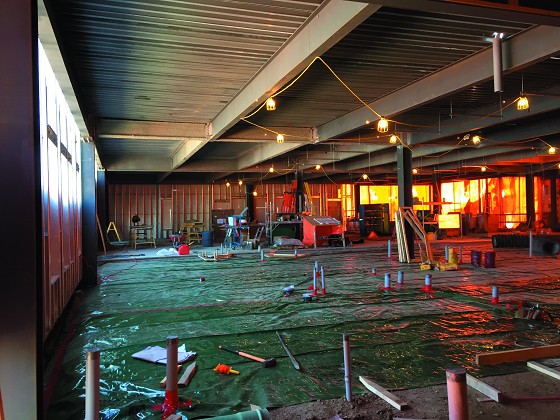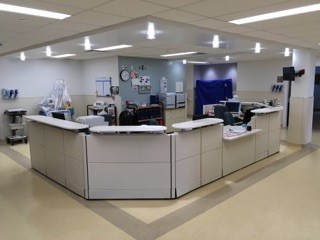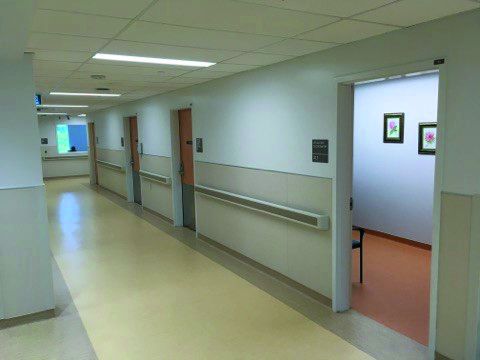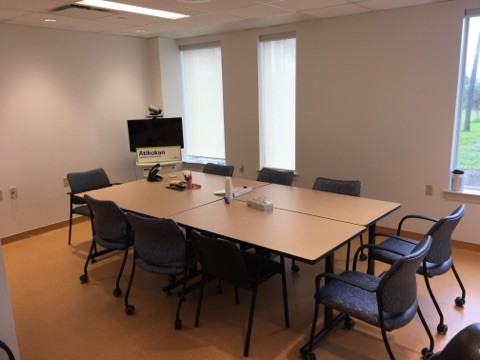Manshield Construction Commended on
Atikokan Hospital Redevelopment and Renovation Project. BEAUTIFUL!
By Sherry Hanes
True dedication to the project. Peter Belluz, President and CEO of Manshield Construction receives Letter of Commendation.Whenever anything old becomes new again, there is a certain excitement
in the air. Such was the case with the redevelopment and renovation of the Atikokan General Hospital, in Atikokan Ontario.On July 29, 2015, Thunder Bay, Atikokan MPP, Bill Mauro announced, investing $11.3 Million for the Redevelopment Project and renovation of the Atikokan General Hospital. The, now completed renovation will provide additional space to give patients better access to care.
The benefits address a more modern facility that delivers improved coordinated and integrated services for patients and the community concerning acute and long-term care. There are four new acute care
beds, bringing the total to 15 beds and four new long-term care beds, bringing the total to 26 beds.
In August 2015, the project was awarded to Manshield Construction of 955 Colbalt Crescent, Thunder Bay, Ontario. Senior Associate, Michael Paquette of Kasian Architecture Ontario Inc. a partner with the
Atikokan General Hospital for many years, is the prime consultant. Manshield Construction is well known for their expertise, financial strength, quality of workmanship and their commitment to timely completion of projects and cost-conscience budgets. Since 1983, Kasian Architecture Ontario Inc. has grown organically into a global practice that believes in the power of inspired thinking, which is the
cornerstone of their culture. Peter Belluz, President and CEO of Manshield Construction, was honoured to be a part of this modernization renovation project of the Atikokan General Hospital as did Kasian
Architecture Ontario Inc.

With the aging population, the update will bring the site into a more accessible reality for those who require services closer to home. According to Hospital President, Doug Moynihan, the hospital will have
the opportunity with additional beds, to have swing rooms. The Ministry of Health and Long-Term Care supports a bit of ‘flexibility’ in certain cases for accommodation. Even though the hospital is
physically expanded, the number of beds will remain at 41. Eight more long-term care beds will be added to the existing twenty-two beds after the new build has been completed.Construction commenced in September 2015, which was a 4-phase construction schedule.
1St Phase was to relocate site services, to accommodate the new building construction.
Phase 2 was, construction of new acute care addition, complete with a fully upgrade electrical system that could service the entire hospital, a complete new mechanical system with an integrated mechanical control room, and the new addition which consisted of deep concrete foundations, structural steel, EPDM roofing (an extremely durable synthetic rubber roofing membrane), composite metal panel siding and all of the interior drywall, painting, millwork and hospital grade specialties.

Phase three and four of the project consisted of moving staff and patients into the new addition and relocating departments around the existing long-term care wing of the hospital to facilitate the renovations.Phase 1): A major part of the project was to relocate the services that interfered with the new addition building footprint. In order to accommodate this, a new electrical service to the entire hospital was constructed as Phase one of the Project. The existing transformer was
removed but, only after its replacement was installed in the new location, tested and commissioned. Storm piping was reworked around the site and new manholes installed to accommodate the new layout. A new outlet was constructed complete with headwalls. The existing water piping was upgraded and relocated to suit the new design including all appurtenances. This portion of the project included clearing and grubbing, excavation, granular backfill and installation of manholes, various piping, valve chambers, headwalls, culverts, roadways, electrical servicing, landscaping work, site grading, ditching,
culverts and construction of a new road access. Commissioning and inspection and verification of the pipe installation was coordinated and managed by Manshield. Phase one was completed in the Fall of
2015.
Phase 2: of the project, the new acute care addition, required the coordination of the internal and external personnel, subcontractors and third-party commissioning agents. The project consisted of a 12,000 sf., addition and a renovation to be existing 15,000 sf., hospital. As any typical hospital, the mechanical and electrical systems are complex. Manshield, as the General Contractor coordinated all of the installations and all of the mechanical and electrical and architectural trades. Space in the ceiling was tight. Piping and ductwork and electrical routing had to be determined well in advance of the time of the anticipated work. In most cases, duct sizes, ceiling heights and routing of the rough-ins, all had to be adjusted to suit existing conditions and the structure. Manshield worked closely with the subtrades and consultants to select the best configurations. During all of this work, outside utilities and inspectors were made aware of the project, coordinated with and provided their inspection and sign off in a timely manner. At the completion of the project, Manshield coordinated outside suppliers of furniture and specialty equipment, that were not within Manshield’s contract. Their on-site personnel made themselves
available and assisted in every manner to get the installations completed alongside the completion of their own work. Manshield received a Letter of Commendation from the hospital, recognizing their
(Mansheild’s) efforts.
Obstacles and Interferences:
Phase 3a) b) and c) and Phase 4a) b) and c), was the relocation of patient areas and staff areas within the hospital and involved significant coordination with the hospital staff and operators. A
complete update of all spaces was accomplished one area at a time. Prior to the first phase of this project taking place, Manshield recognized that the current specification required only portions of
unwanted substances within the old hospital to be removed. Manshield worked with the key subtrades to recommend a plan whereby ALL of the unwanted substances be removed and replaced. Keating Insulation was instrumental in the plan and provided extra value to the project, at no additional cost to the Owner.

The entire Mechanical and Electrical systems were updated and replaced in this phase of the work that took place within a functional hospital. Manshield and the subcontractors had to comply with Infection Control policies at all times. Manshield provided temporary dust-proof partitions to separate the work areas from occupied hospital areas, as there was zero tolerance for the entry of dust into occupied
areas. One major moved consisted of the relocation of the Nurses Station. Manshield coordinated all of the required mechanical and electrical and communications, required to complete the move.
New systems were put into place and tested and commissioned prior to the move taking place on the specified and agreed upon date. Manshield’s on-site staff were available at all times and assisted the hospital personnel to ensure the move proceeded as smoothly as possible.Manshield had this to say about the project: While not a large project in size, this was a very challenging project. The challenges almost, exclusively, involved the existing conditions inside the existing hospital. The first phase of the project involved relocation of the entire electrical service. The electrical equipment was pre-ordered in
order to save time so that the work could proceed immediately upon award of the contract. It was immediately discovered that the equipment would not fit into the existing electrical room, located in
the basement of the existing hospital. Manshield, together with the subtrades and the consultants, devised a solution to the space problems and immediately commenced on the corrective actions required. While this cause some time to be lost at the outset of the project, it did not result in any additional costs to the Owner.The space available for each renovation phase was extremely limited due
to the fact that the hospital required much of the available for the patients.

Manshield worked in these small renovation areas, completing one section at a time and turning it over to the hospital, who would then move patients and services around and turn over the next renovation area to Manshield. The hospital was built in the 1950’s, so there was no question that there was much to be done, and Manshield, being awarded the contract, delivered absolutely professional, quality workmanship but, also went the extra mile to satisfy the completion of this much needed redevelopment and renovation. The project was slated for $11.3 Million. Only 4% in extra costs was required for the completion of the project and that is amazing for an existing hospital renovation. The fourty-five strong man power, under the direction of Manshield and Manshield Construction Company, should all be proud of such a project as it will not go into the history books until the next redevelopment and renovation … probably in another 68 years from now.
Congratulations to everyone at Manshield Construction and everyone at the Atikokan General Hospital!









